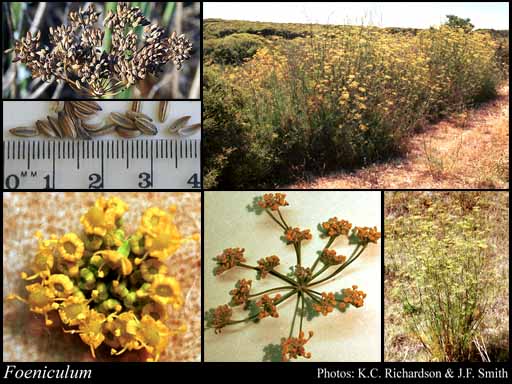- Reference
- Gard.Dict. 3:. (1754)
- Name Status
- Current

Scientific Description
Family Apiaceae.
Habit and leaf form. Tall herbs; bearing essential oils, or without essential oils (?); resinous, or not resinous (?). Annual, or biennial, or perennial; plants with a basal concentration of leaves, or with neither basal nor terminal concentrations of leaves (?). Helophytic, or mesophytic. Leaves medium-sized to very large; alternate; ‘herbaceous’; petiolate. Petioles hollow with broad sheathing base. Leaves more or less sheathing. Leaf sheaths with free margins. Leaves gland-dotted, or not gland-dotted (?); aromatic (with aniseed odour); simple, or compound; pulvinate, or epulvinate (?); bipinnate, or multiply compound (3–4-pinnate, the ultimate segments filiform). Leaf blades when simple, dissected; much-divided (3–4 times pinnatisect); pinnately veined, or palmately veined, or parallel-veined (?). Leaves without stipules; without a persistent basal meristem. Leaf anatomy. Hairs absent. Stem anatomy. Nodes multilacunar, or tri-lacunar (?). Secondary thickening developing from a conventional cambial ring, or anomalous (?); from a single cambial ring.
Reproductive type, pollination. Fertile flowers hermaphrodite. Unisexual flowers absent. Plants hermaphrodite. Entomophilous.
Inflorescence and flower features. Flowers aggregated in ‘inflorescences’; in umbels. Inflorescences compound. The terminal inflorescence unit cymose, or racemose (?). Inflorescences terminal; without ray bracts. Flowers pedicellate. Pedicels unequal. Flowers ebracteate; small; regular to somewhat irregular (?); 5 merous (except for the gynoecium); cyclic; tricyclic. Free hypanthium absent. Perianth petaline (sepals absent or sometimes interpreted as a thick rim at the ovary apex); 5; 1 -whorled; yellow. Corolla 5; 1 -whorled; polypetalous; valvate; unequal but not bilabiate, or regular (?); yellow. Petals oblong to obovate (apex rolled inwards). Androecium 5. Androecial members free of the perianth; all equal to markedly unequal (?); free of one another; 1 -whorled. Androecium exclusively of fertile stamens. Stamens 5; isomerous with the perianth; oppositisepalous; inflexed in bud. Anthers almost circular in outline; dehiscing via longitudinal slits; introrse; tetrasporangiate. Gynoecium 2 carpelled. The pistil 2 celled. Gynoecium syncarpous; synovarious; inferior. Ovary plurilocular; 2 locular. Gynoecium median. Epigynous disk present. Gynoecium stylate. Styles 2; free to partially joined (their bases thickened into a conical stylopodium crowning the ovary); apical. Stigmas wet type; non-papillate; Group IV type. Placentation axile, or apical (?). Ovules 1 per locule, or 2 per locule (usually two, but one abortive ?); pendulous; epitropous; non-arillate; anatropous.
Fruit and seed features. Fruit non-fleshy; not hairy; a schizocarp. Mericarps 2 (prominently 5-ribbed). Seeds endospermic. Endosperm oily. Embryo well differentiated. Cotyledons 2. Embryo achlorophyllous; straight. Seedling. Germination phanerocotylar.
Physiology, biochemistry. Aluminium accumulation not found. Photosynthetic pathway: C3.
Geography, cytology, number of species. Adventive. Australian states and territories: Western Australia, South Australia, Queensland, New South Wales, Victoria, Australian Capital Territory, and Tasmania.
Economic uses, etc. Food plant (fennel).